The secret of going from 50,000 to 30 million: In 2019, I was still eating instant noodles, but by 2024, I had achieved financial freedom.
Ten years ago, when I first entered the cryptocurrency circle, like most retail investors, profits and losses seemed entirely dependent on luck, and I could not grasp any patterns.
However, after spending a few years in the cryptocurrency circle, through continuous learning and absorption, as well as the ongoing sharing and guidance from mentors and seniors, I finally began to understand and form my own investment system!
Today, I will share my trading strategies and insights with friends in the cryptocurrency circle.
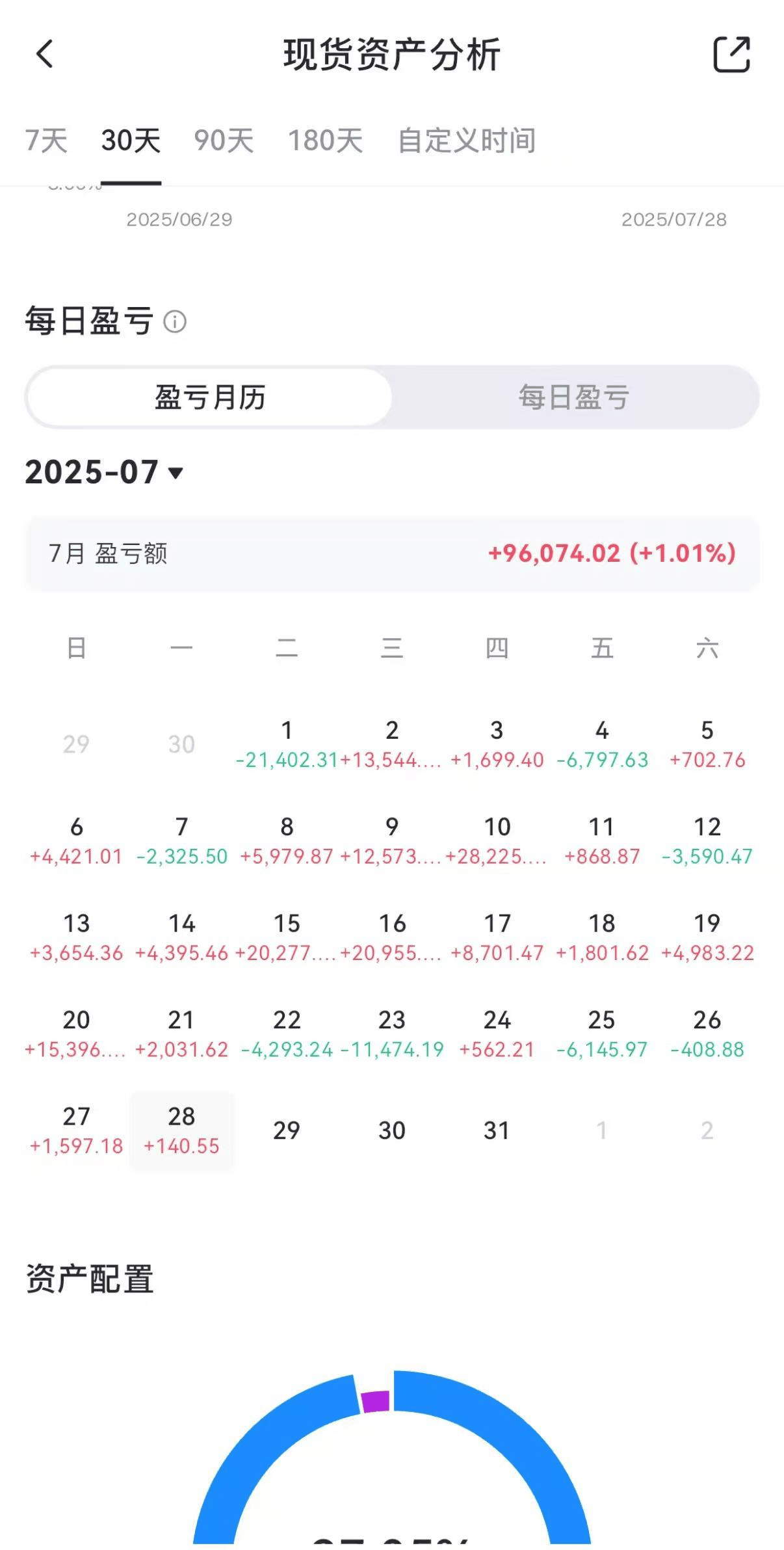
Making 30 million? My true experience and core strategies (2020-2024).
1. Initial stage: From 100,000 to 1 million (2020-2021).
Seize the DeFi summer (2020).
Strategy: Early participation in liquidity mining (such as Uniswap, Sushiswap).
Key operations:
Using 50,000 principal to provide ETH+-USDT liquidity, annualized returns of 300%-1000%.
Mining tokens (UNI, SUSHI) skyrocketed after listing, yielding profits of 500,000.
Lesson: The risk of constant losses is high; you need to calculate the breakeven point of the LP pool.
2. Layout in the early stages of a bull market (2021).
Strategy: Heavily invest in BTC and ETH, with small positions on altcoins.
Key operations: BTC rose from 10,000 to 10,000 to 60,000, with a position increase of 6 times; ETH rose from 400 to 400 to 4,800, with a position increase of 12 times; small coins (like SOL, MATIC) saw some positions increase by 20-50 times.
Result: By the end of 2021, assets exceeded 5 million.
2. Advanced stage: From 5 million to 15 million (2022-2023)
1. Escaping the peak of the 2021 bull market.
Strategy: Observe market sentiment + on-chain data.
Key indicators: Exchange BTC stock increase (whales start to offload) Fear and Greed Index > 90 (extreme greed) BTC futures funding rates unusually high (longs overheating).
Operations: In November 2021, when BTC approached $69,000, sell 80% of the position in batches, keeping 20% in spot to avoid missing out.
2. Bottom fishing in the bear market of 2022.
Strategy: Dollar-cost averaging + increasing positions at key support levels.
Key operations: Start dollar-cost averaging BTC below $20,000 (buy weekly), gradually increase positions for ETH below $1,000, and layout for Layer 2 tracks (ARB+, OP).
Result: When the bull market started in 2023, the value of the holdings rebounded to 15 million.
3. In 2023, seize narrative hot spots.
Strategy: Anticipate market hot spots.
Key operations: BRC-20 (ORDI): Buy 3, sell 90, achieving 30 times returns.
Solana ecosystem (BONK, PYTH): Low position layout, some positions 10-50 times.
AI track (RNDR, TAO): Build positions at the beginning of 2023, explosive growth in 2024.
3. The explosive phase: From 15 million to 30 million.
1. The main wave of the bull market in 2024.
Strategy: Trend trading + swing arbitrage.
Key operations: After the BTC ETF is approved, the price rises from 30,000 to 30,000 to 70,000, doubling the position.
ETH Cancun upgrade drives the L2 sector (ARB, STRK) to rise.
The meme coin craze (PEPE, WIF) generated short-term trading profits.
2. Precision targeting in contracts (high risk).
Strategy: Low leverage (5-10 times) + trend following.
Key operations: Open long when BTC breaks 50,000, set stop loss at 48,000, and ultimately rise to $70,000. Increase positions for ETH after breaking 3,000, target 4,000, with profits exceeding 30%.
Risk control: Individual contract positions should not exceed 5% of total funds; implement strict stop-loss to avoid emotional holding of positions.
3. Cross-market arbitrage.
Strategy: Utilize the price difference of exchanges + arbitrage between spot and futures.
Key operations: Binance vs. OKX BTC price difference arbitrage (annualized 15%-30%) BTC spot vs. futures positive premium arbitrage (locking in risk-free returns).
Summary of core profit logic.
1. Long-term value investment (50% position).
BTC and ETH as core assets should be held long-term.
Layer 2, AI, Depin, and other leading projects.
2. Trend trading (30% position)
Increase positions during the main uptrend of the bull market, dollar-cost average at the bottom.
Combine technical analysis (EMA, RSI) to improve win rates.
3. Short-term speculative hot spots (20% position)
Seize the market's FOMO sentiment (such as meme coins, new public chains).
Quick in and out; do not linger in battle.
4. Strict risk control (most important!)
Never go all-in; individual coin positions should not exceed 20%.
Discipline in stop-loss; if losses exceed 10%, exit forcibly.
Cash flow management, keep 30% cash to cope with extreme market conditions.
Five, advice for ordinary investors.
1. Do not fantasize about getting rich overnight; 90% of contract players will ultimately go to zero.
2. Dollar-cost average in bear markets, take profits in bull markets; cycles are more important than techniques.
3. Focus on on-chain data; whale movements are more real than K-lines.
4. Continuously learn; the market is evolving, and strategies must be updated.
Investment is just one of the games you experience in life. The success or failure of investment has little to do with your skills; it depends on your information sources and luck. In short, the tricks of the old nobility to oppress and exploit the common people have been dressed in a layer of noble clothing in the new era. Since I have said so much, let me also share how I do it.
Today, I will focus on sharing the MACD strategy I use the most, the basic usage of MACD, and the divergence between tops and bottoms in MACD.
MACD divergences frequently occur. Utilizing this buy-sell signal in the market has a high accuracy rate, making it one of the more useful technical tools. However, due to its high accuracy, it is often exploited by main funds, leading to divergence traps. When encountering this situation, more evidence should be added to ensure the accuracy of our judgments.
1. The collaborative judgment of MACD and other indicators.
(1) The combination of MACD and moving averages.
Top divergence occurs.
At that time, if the moving averages have significant support for the stock price's pullback, it indicates that the bullish strength below is relatively strong. Observe if they can easily break through the support level, and if so, sell decisively at high points.
When a bottom divergence occurs, the pressure from the moving averages on the rise is evident, and it is time to take profits at high points, waiting for a breakthrough of the moving average position to buy at lower points again.
Example 1: Using the top divergence of BTC that appeared in May 2019 at the 4-hour level as a case study, after the 4-hour top divergence, a pullback occurred, with the MA60 providing support and the upward trend remaining intact.
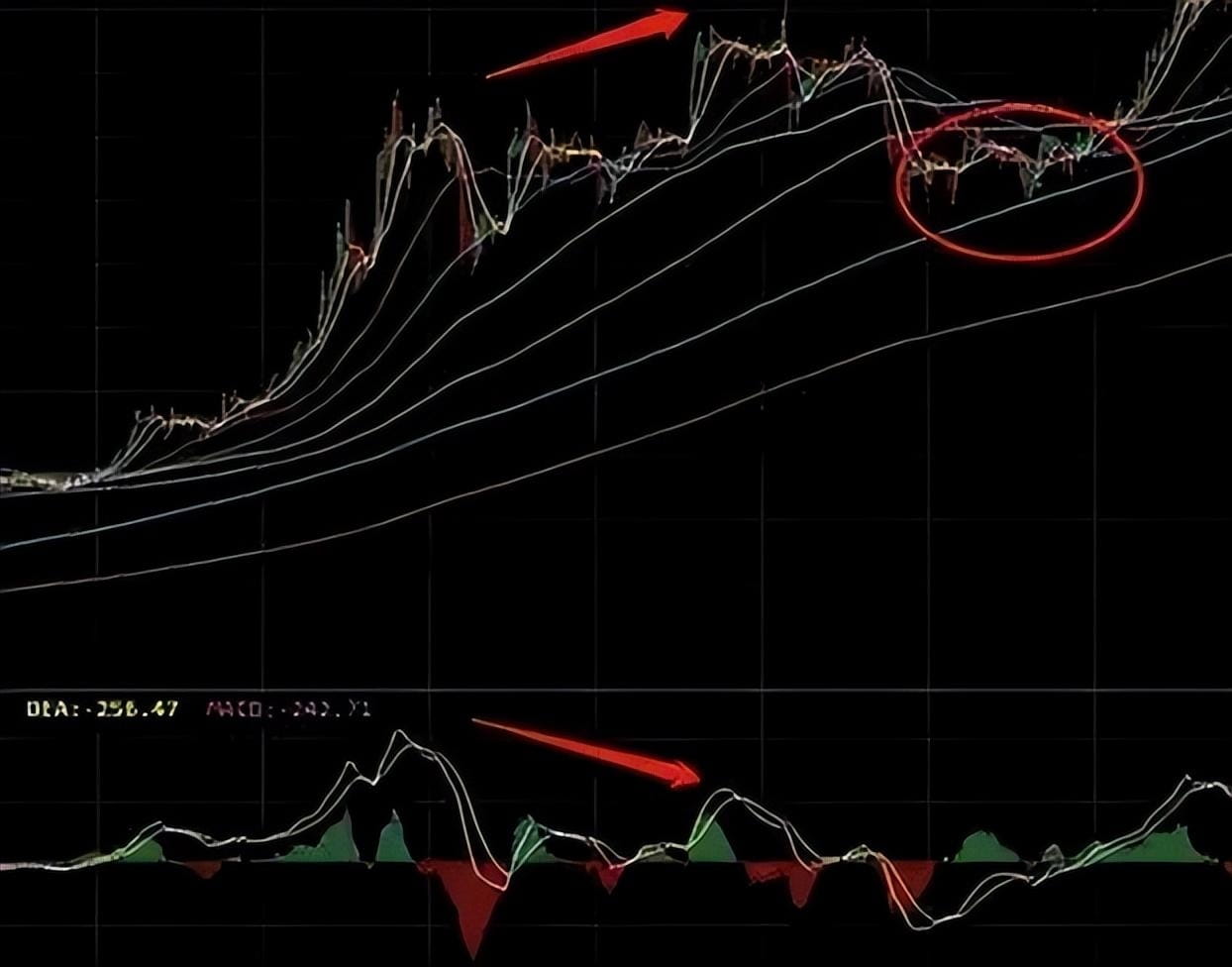 Example 2: EOS on the daily chart at the end of 2018. After the daily chart showed a bottom divergence, it broke through the 30-day moving average with increased volume and continued upward, with reduced volume during pullbacks providing strong support at the 60-day moving average.
Example 2: EOS on the daily chart at the end of 2018. After the daily chart showed a bottom divergence, it broke through the 30-day moving average with increased volume and continued upward, with reduced volume during pullbacks providing strong support at the 60-day moving average.
 Example 3: Let's make a comparison. EOS experienced MACD divergence in June-August 2018 on the daily chart, but during the rebound, it encountered strong resistance from the moving averages above, which it could not break through after a prolonged attack, ultimately choosing to continue downward.
Example 3: Let's make a comparison. EOS experienced MACD divergence in June-August 2018 on the daily chart, but during the rebound, it encountered strong resistance from the moving averages above, which it could not break through after a prolonged attack, ultimately choosing to continue downward.
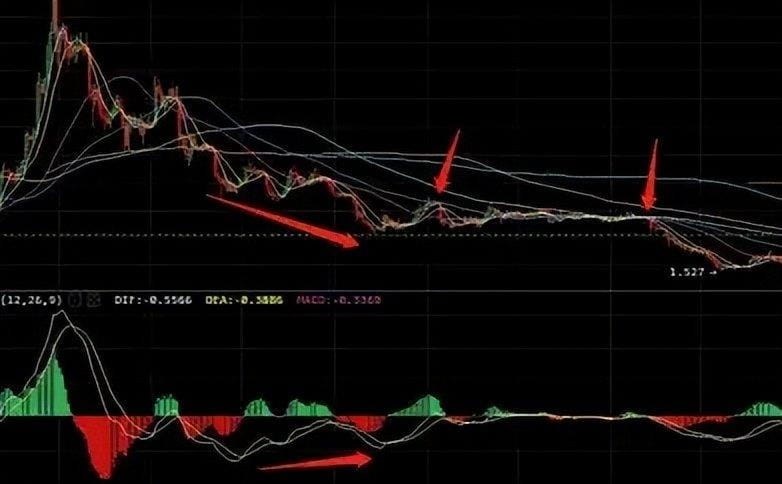 (2) The combination of MACD and volume.
(2) The combination of MACD and volume.
Price, volume, and MACD are the most commonly used set of indicators. Volume represents upward momentum; low volume indicates waning upward momentum. All significant uptrends are pushed by volume, while all significant downtrends are created by volume. Therefore, trading volume is a very important reference indicator.
When a top divergence occurs, if trading volume does not contract and funds are still entering, it is best to wait temporarily. If there is a contraction during an upward move, it indicates a peak. A significant increase in volume raises suspicions of selling by the bulls, so it is also necessary to protect profits. During a bottom divergence, if trading volume does not change much, you can hold; if there is a large volume drop, panic selling may occur, indicating room for further declines in the future.
Example 1: Again, using the top divergence of BTC that appeared in May 2019 at the 4-hour level as a case study.
When the price reaches new highs, but the MACD indicator does not create a new high, while simultaneously, trading volume has shrunk compared to the last round of increases, it indicates weakness in the rise. The synergy with MACD's top divergence is a signal of a peak at the 4-hour level.
 Example 2: EOS on the daily chart at the end of 2018. The price continued to fall to new lows, but MACD did not make new lows, and the corresponding trading volume's red bars shortened, indicating a contraction in selling pressure. The synergy with MACD's bottom divergence is a signal of a bottom.
Example 2: EOS on the daily chart at the end of 2018. The price continued to fall to new lows, but MACD did not make new lows, and the corresponding trading volume's red bars shortened, indicating a contraction in selling pressure. The synergy with MACD's bottom divergence is a signal of a bottom.
 (3) The combination of MACD and KD.
(3) The combination of MACD and KD.
KDJ is a cyclical indicator, with good reference for emphasizing turning points. The downside is that it is too sensitive to fluctuations and can easily lead to false signals. It is suitable for short-term indicators.
Example 1: Let's use the top divergence of BTC that appeared in May 2019 at the 4-hour level as a case study. The price continually reached new highs, but MACD did not reach new highs, and KDJ was above 80 in the overbought area, with divergence occurring. The synergy with MACD's top divergence is a signal of a peak.
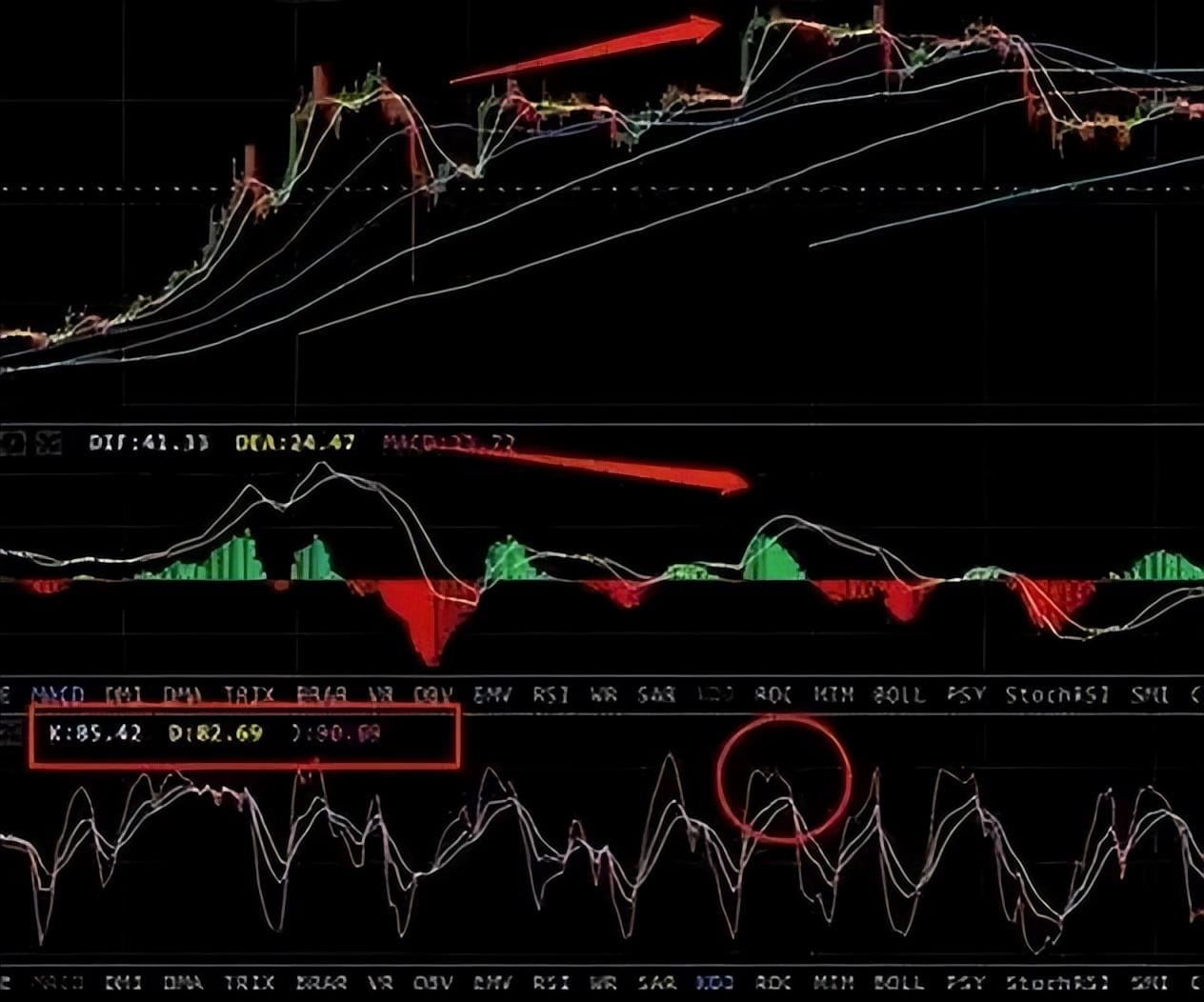 Example 2: EOS daily chart at the end of 2018. The price continued to fall to new lows, but MACD did not reach new lows, and KDJ remained below 10 in the oversold zone, while also exhibiting low divergence. The synergy with MACD's bottom divergence is a signal of a bottom.
Example 2: EOS daily chart at the end of 2018. The price continued to fall to new lows, but MACD did not reach new lows, and KDJ remained below 10 in the oversold zone, while also exhibiting low divergence. The synergy with MACD's bottom divergence is a signal of a bottom.
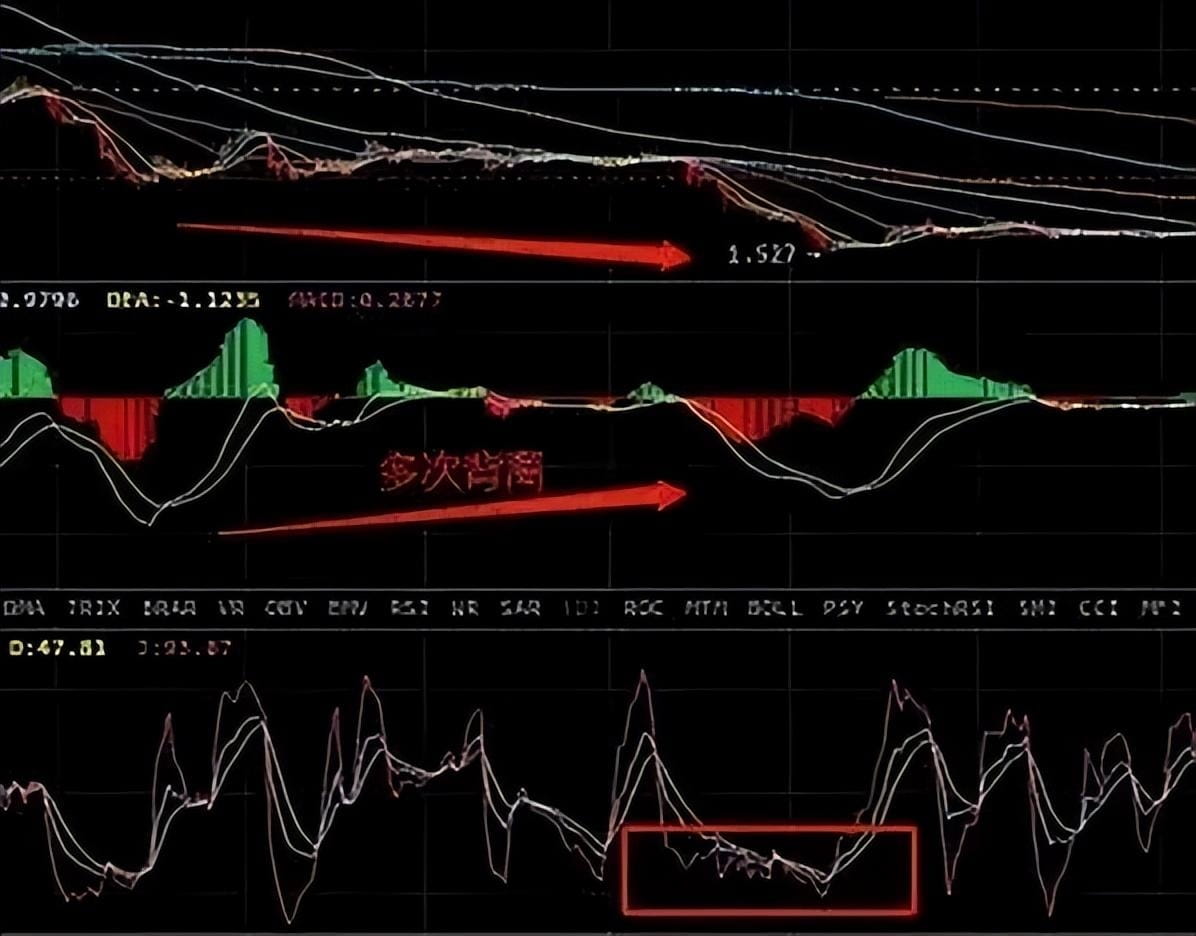 (4) The combination of MACD and RSI.
(4) The combination of MACD and RSI.
RSI is a market strength indicator, indicating the strength of bulls and bears, relatively sensitive. It is suitable for short-term indicators.
Example 1: Again, using the top divergence of BTC that appeared in May 2019 at the 4-hour level as a case study. The price continually reached new highs, but MACD did not make new highs, and RSI was above 80 in the overbought area, showing divergence. The synergy with MACD's top divergence is a signal of a peak.
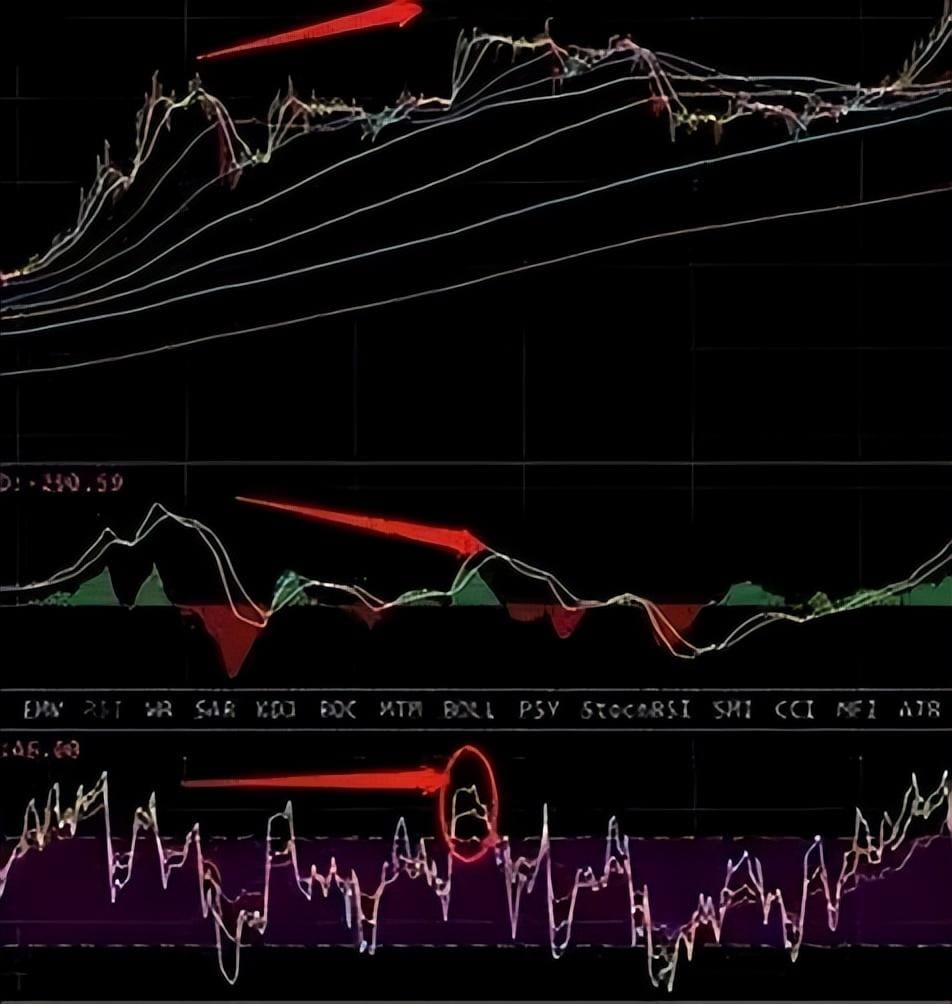 Example 2: EOS daily chart at the end of 2018. The price continuously fell to new lows, but MACD did not make new lows, RSI remained below 10 in the oversold zone and did not create new lows, showing bottom divergence. The synergy with MACD's bottom divergence is a signal of a bottom.
Example 2: EOS daily chart at the end of 2018. The price continuously fell to new lows, but MACD did not make new lows, RSI remained below 10 in the oversold zone and did not create new lows, showing bottom divergence. The synergy with MACD's bottom divergence is a signal of a bottom.
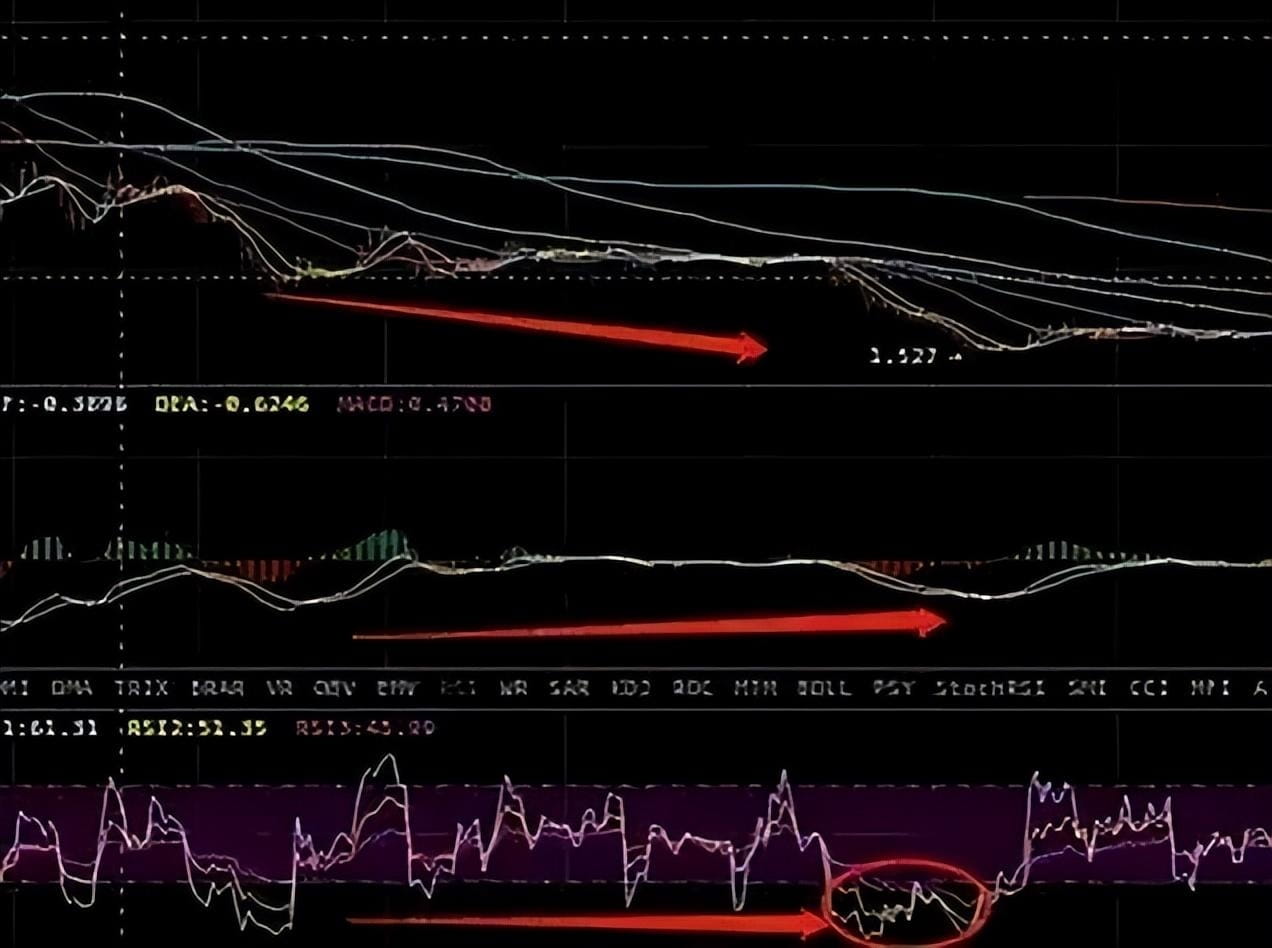 Above, several indicators can be combined into one chart. The more indicators that show divergence at the same time, the greater the probability of a peak or bottom turning point.
Above, several indicators can be combined into one chart. The more indicators that show divergence at the same time, the greater the probability of a peak or bottom turning point.
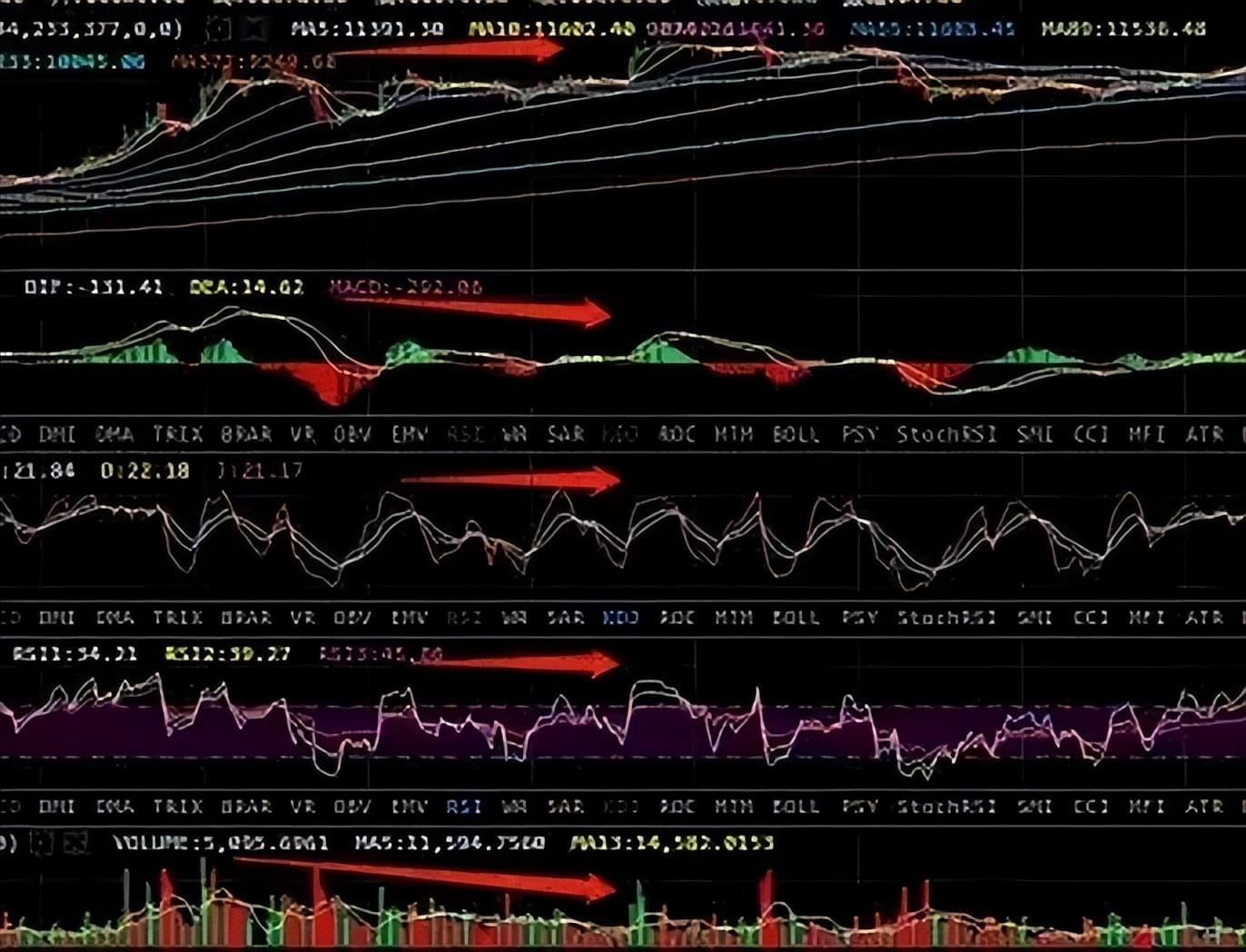 2. Eight common MACD patterns.
2. Eight common MACD patterns.
(1) Buddha's hand upward: After the fast line and slow line form a golden cross, it rises with the stock price, then follows the stock price down during the correction.
Usually, when the main force is washing out positions, the stock price retraces, causing the fast line to return to near the MACD line, and then the fast line immediately turns upward, forming the Buddha's hand upward shape.
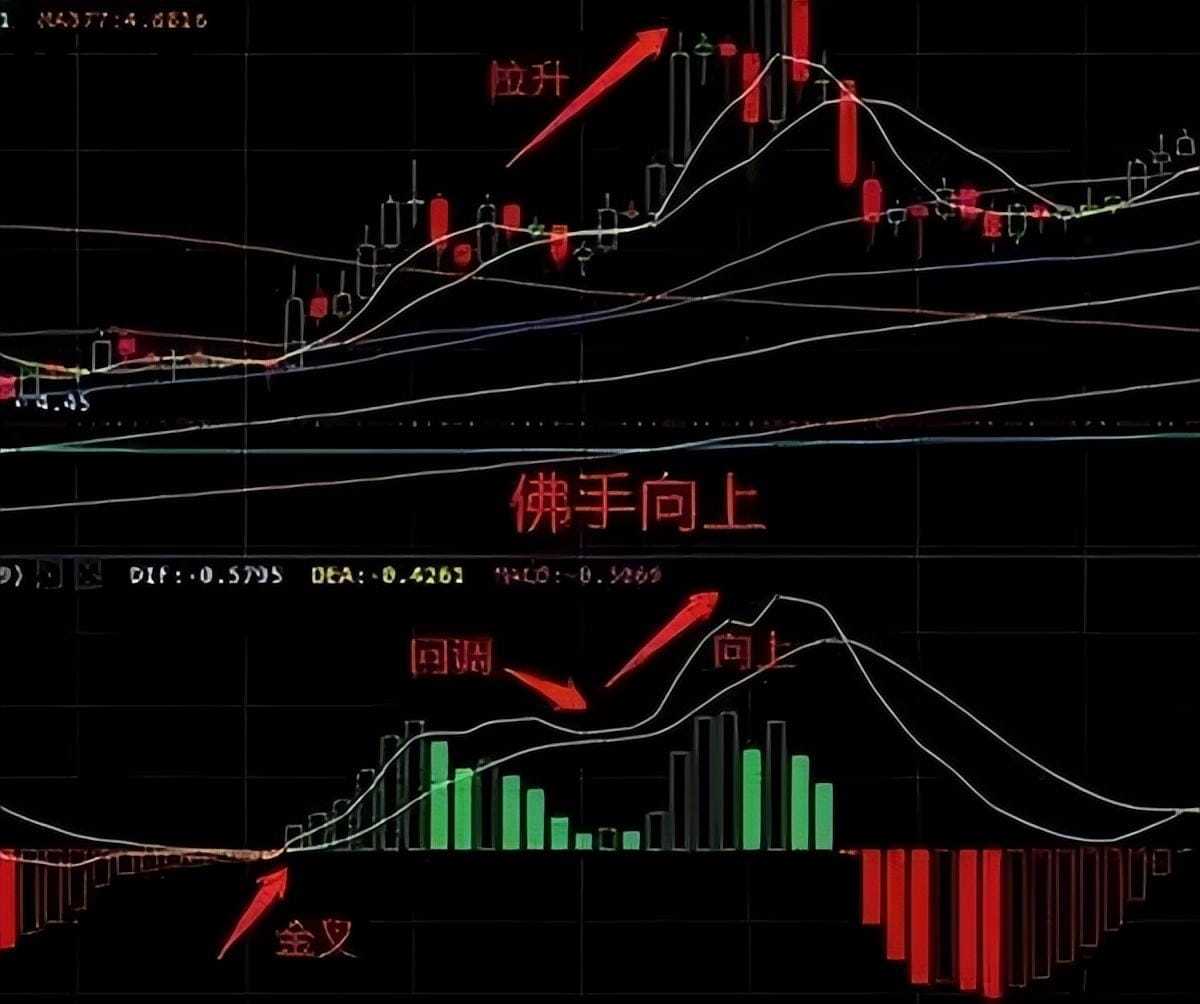 (2) Duckling emerging from the water: The fast line forms a golden cross with the slow line below the 0 axis but does not cross above the 0 axis, or just crosses above slightly before returning below the 0 axis, then a dead cross occurs with the slow line. After a few days, it forms a golden cross with the fast line again.
(2) Duckling emerging from the water: The fast line forms a golden cross with the slow line below the 0 axis but does not cross above the 0 axis, or just crosses above slightly before returning below the 0 axis, then a dead cross occurs with the slow line. After a few days, it forms a golden cross with the fast line again.
This pattern is a bottom formation that occurs when the stock price has fallen to a low and the selling pressure has been exhausted. It should be understood as a signal of a rebound from the bottom, allowing for market entry at the right time.
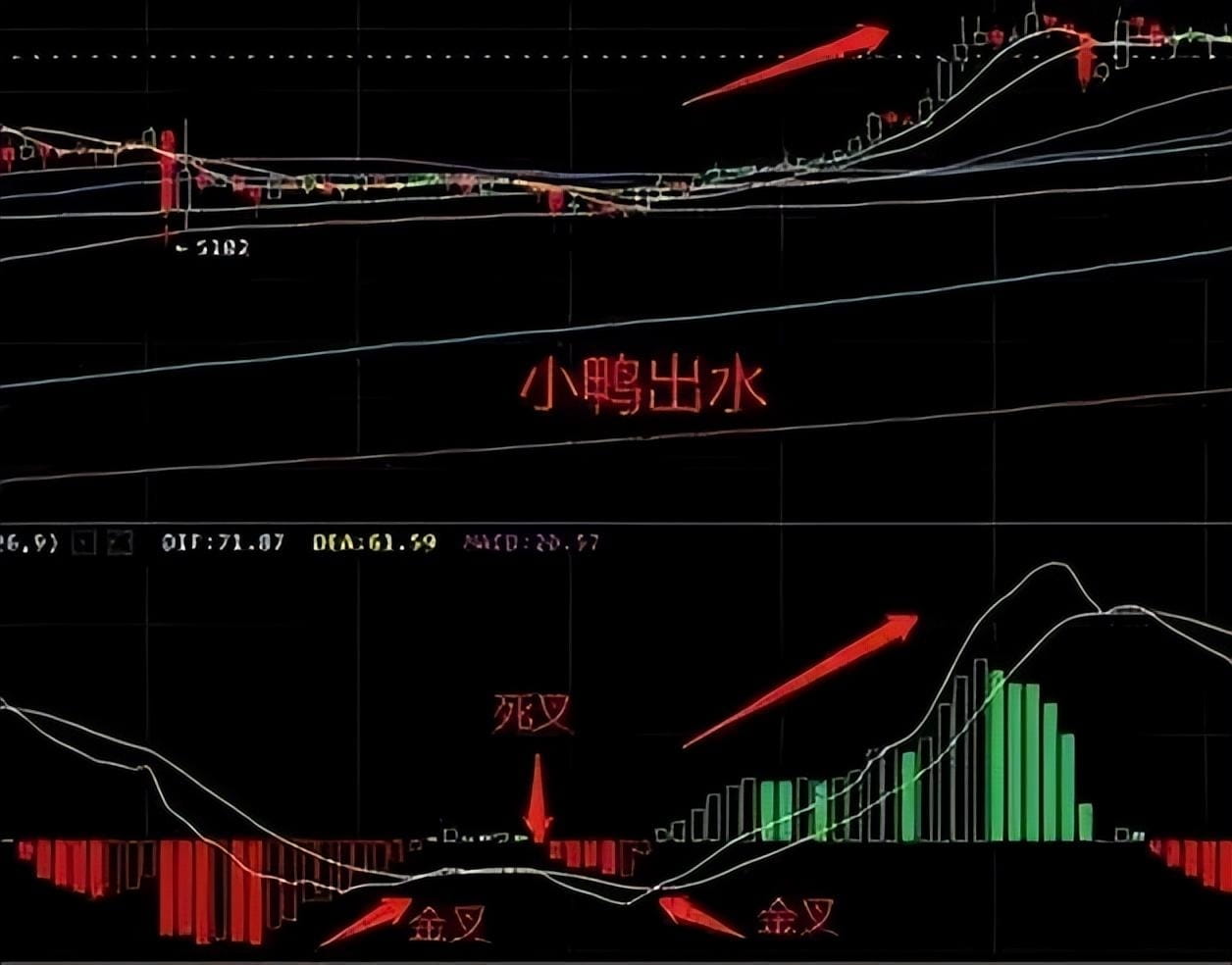 (3) Wandering in the clouds: The fast line dead crosses the slow line above the zero axis, continuing to fall below the zero axis, then forms a golden cross with the slow line at or above the zero axis. The K-line shape at this time often crosses or is crossing important moving averages.
(3) Wandering in the clouds: The fast line dead crosses the slow line above the zero axis, continuing to fall below the zero axis, then forms a golden cross with the slow line at or above the zero axis. The K-line shape at this time often crosses or is crossing important moving averages.
This shape forms when the stock price is consolidating during the process of bottoming out. It may also be a bottoming formation showing upward momentum, which should be understood as a positive entry signal, and one should act decisively in the market.
 (4) Swan spreading wings: The fast line forms a golden cross with the slow line below the 0 axis, but does not cross above the 0 axis before correcting, approaching the fast line. The MACD green bars shorten, but there is no dead cross with the slow line; it then reverses upward again, while also extending the MACD green bars, forming the swan spreading wings shape.
(4) Swan spreading wings: The fast line forms a golden cross with the slow line below the 0 axis, but does not cross above the 0 axis before correcting, approaching the fast line. The MACD green bars shorten, but there is no dead cross with the slow line; it then reverses upward again, while also extending the MACD green bars, forming the swan spreading wings shape.
The formation of this shape is often a bottom formation. It occurs when the stock price has fallen to a low and the selling pressure has exhausted, and it should be understood as the main force's accumulation area, allowing for market entry at the right time.
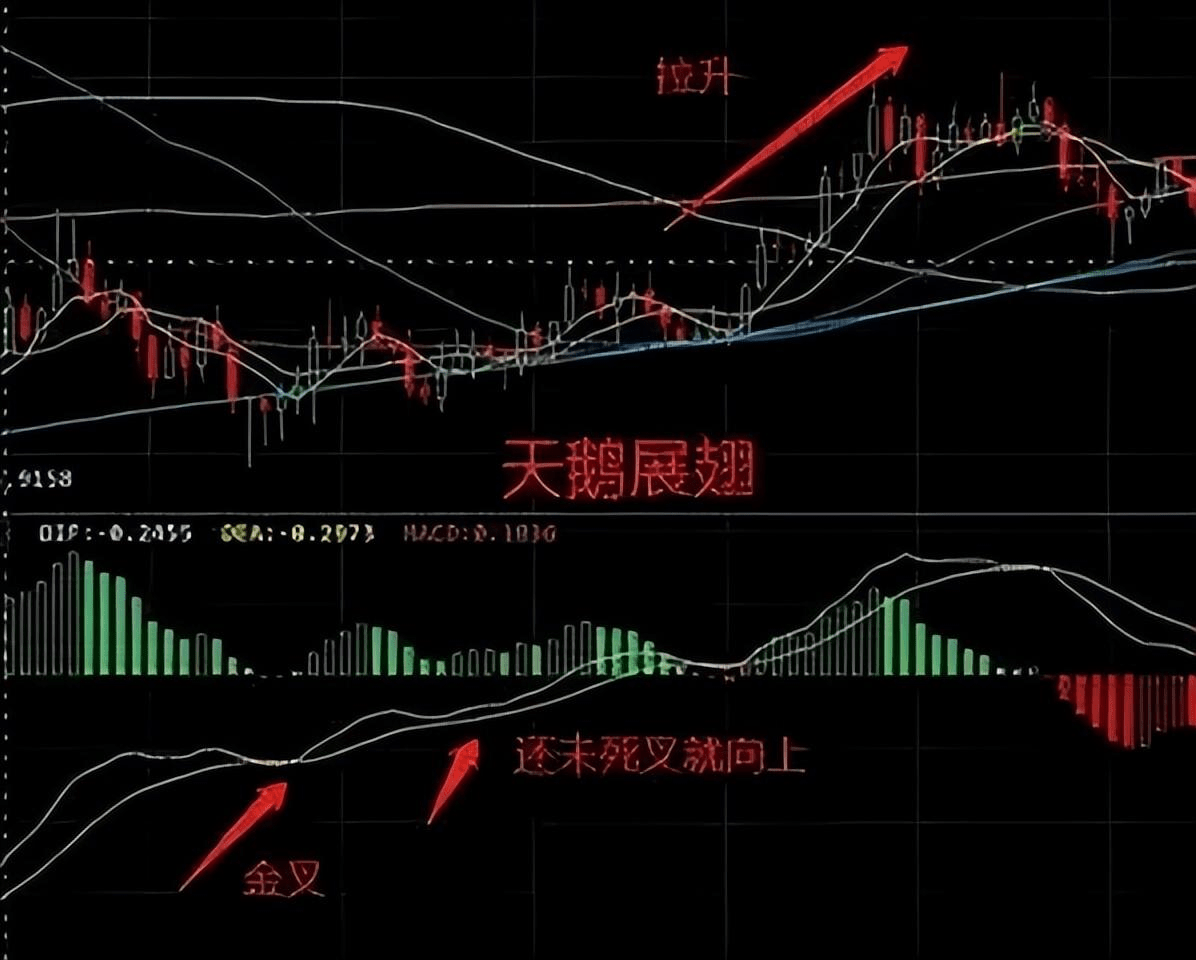
(5) Undersea cable: When MACD has been running at the 0 axis for a relatively long time, and the fast line forms a golden cross with the slow line below the 0 axis, the two lines begin to merge into one line with equal values. If a bullish divergence occurs upward, it is an opportunity to buy.
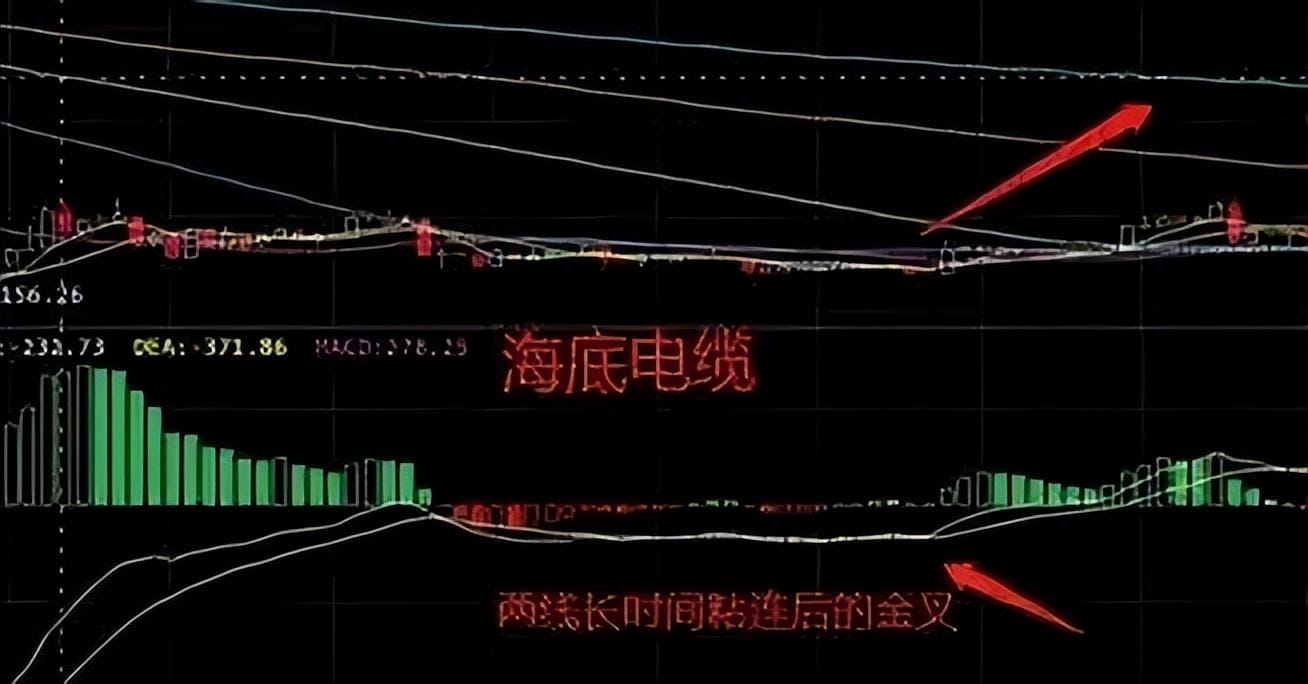 (6) Fishing in the bottom of the sea: When the fast line produces a golden cross below the 0 axis for the second time, it indicates that the bottom has been completed, and it starts to rise from the bottom, allowing for buying opportunities.
(6) Fishing in the bottom of the sea: When the fast line produces a golden cross below the 0 axis for the second time, it indicates that the bottom has been completed, and it starts to rise from the bottom, allowing for buying opportunities.
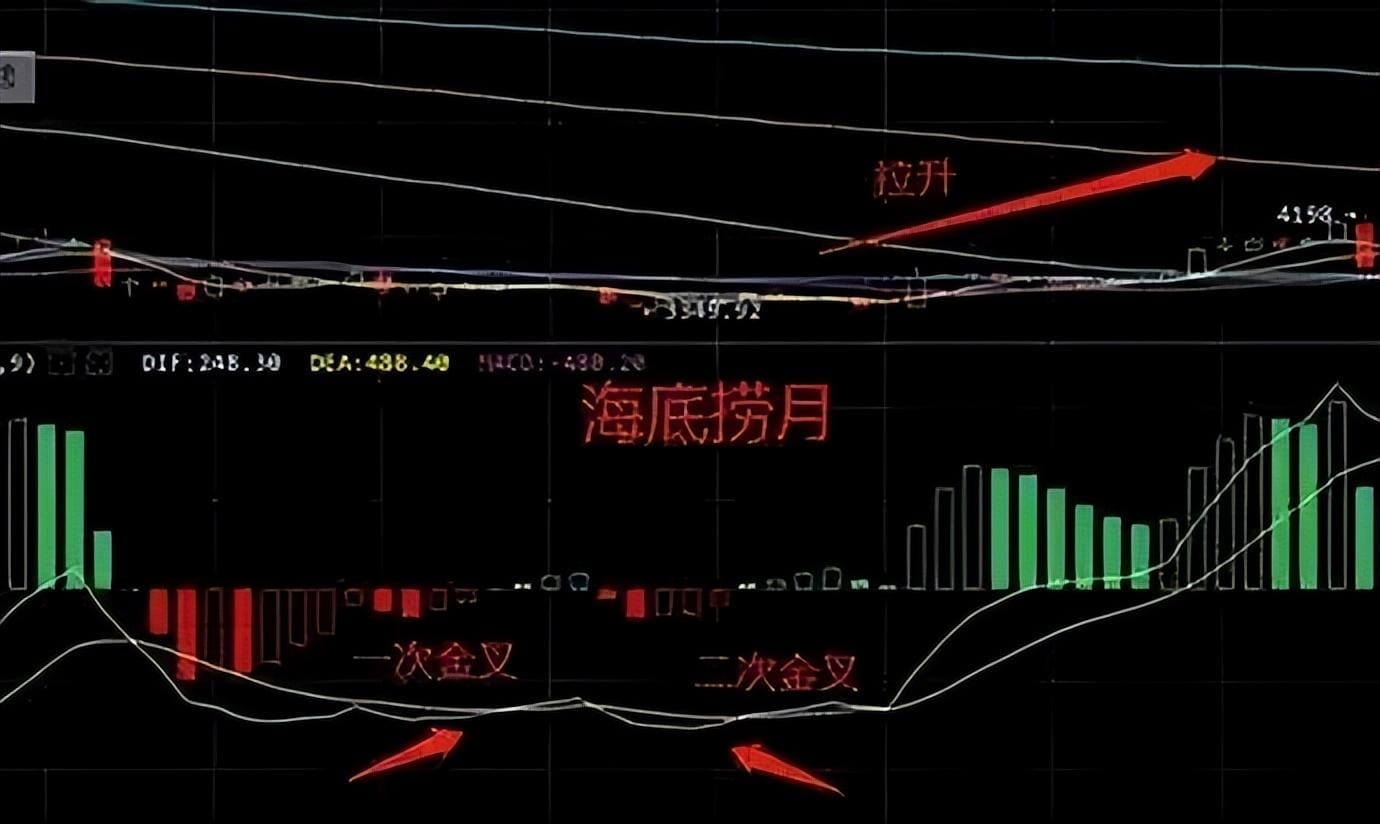 (7) Aerial rope: After the fast line forms a golden cross with the slow line below the 0 axis, it continues to run above the 0 axis for a while, and when the price adjusts, the fast line also begins to adjust downward. When the fast line touches the slow line, the two lines merge into one line.
(7) Aerial rope: After the fast line forms a golden cross with the slow line below the 0 axis, it continues to run above the 0 axis for a while, and when the price adjusts, the fast line also begins to adjust downward. When the fast line touches the slow line, the two lines merge into one line.
When they separate and show bullish development, that is the time to buy. A new wave of upward momentum is about to begin. This pattern usually presents after a slight setback during an upward trend, showing a strong upward attack pattern.
 (8) Aerial cable car: The main difference between this shape and the aerial rope is that the aerial rope does not have a dead cross, while the aerial cable car will have a dead cross. A similar point is that everyone's moving averages are in a bullish arrangement.
(8) Aerial cable car: The main difference between this shape and the aerial rope is that the aerial rope does not have a dead cross, while the aerial cable car will have a dead cross. A similar point is that everyone's moving averages are in a bullish arrangement.
As shown in the figure, DI dead crosses DEA above the 0 axis.
However, if it does not cross below the 0 axis first, it may form a golden cross with DEA above the 0 axis again after a few days. This pattern usually indicates that the price has shown strong upward momentum after a brief adjustment, which is a positive entry signal. If it can continue to increase in volume, it becomes a must-not-miss opportunity.
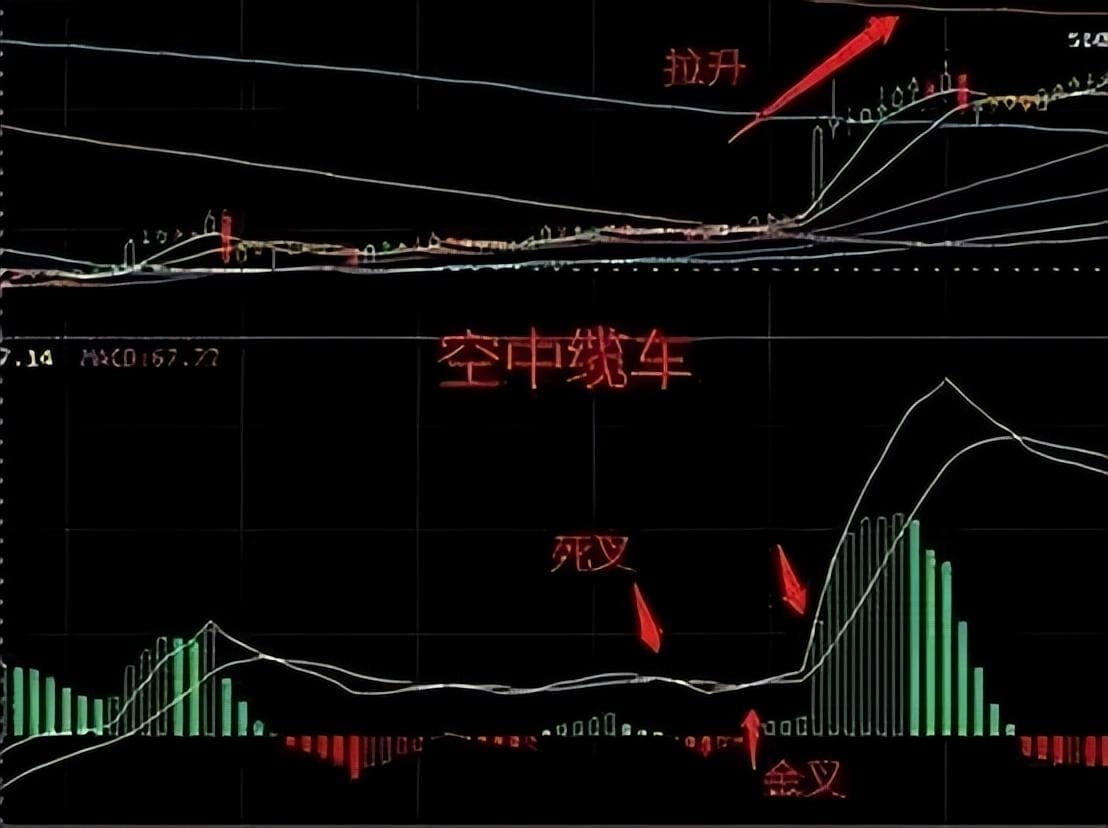 To date, we have introduced what MACD is, how to find buy and sell points using divergences, the synergy with four commonly used indicators, and the eight common MACD patterns through three lectures.
To date, we have introduced what MACD is, how to find buy and sell points using divergences, the synergy with four commonly used indicators, and the eight common MACD patterns through three lectures.
That's it for the MACD indicator. In the future, as you continue to learn, you will gain a deeper understanding of the application of MACD divergence.
Twelve pieces of advice for newcomers in the cryptocurrency circle!
The first piece of advice.
The cryptocurrency market has bid farewell to barbaric growth and is stepping into a stage of institutional finance, with competition among capital institutions becoming increasingly fierce. Do not fantasize about easily creating a coin that can yield a hundredfold return; nowadays, in the current market sentiment, coins that can multiply ten times are already rare. Even when a bull market arrives, coins that can bring substantial gains will be few and far between.
The second piece of advice.
Participating in the primary market looks tempting, but in reality, it carries huge risks. Most projects will ultimately go to zero, and those who encourage you to participate often do not disclose this truth. Even if a project is listed on an exchange, some so-called opinion leaders will advise you to hold during their sell-off while they have already exited.
The third piece of advice.
Although full-margin betting and leveraged trading in contracts can be tempting, they also come with enormous risks. The essence of cryptocurrency trading lies in stable operations, rolling over positions to accumulate profits, rather than seeking huge profits from single trades.
The fourth piece of advice.
When someone is frantically promoting a certain coin, it usually means that the coin is close to its peak. If you previously held that coin, consider selling in a timely manner; if you do not hold it, do not blindly enter to avoid becoming a bag holder.
The fifth piece of advice.
Regardless of whether you are a college student or a young person, you should prioritize your studies and self-improvement, with cryptocurrency trading as an auxiliary means. Trading is a long-term battle that requires patience and perseverance. At the same time, having a stable source of income and excellent off-market earning ability will provide strong support for your trading journey.
The sixth piece of advice.
Wealth requires patient accumulation. Stay calm and rational while trading, understanding the principle that gains and losses come from the same source. Regardless of profit or loss, blessings and virtue accompany you, and you should promptly summarize experiences and reflect on your trading decisions. Emotional traders often struggle to achieve long-term success.
The seventh piece of advice.
Ways to make money are often not shared easily. If someone is promoting the benefits of a certain coin, be sure to remain cautious to avoid becoming a target for being harvested.
The eighth piece of advice.
Be cautious of those who boast about their holding profits. They may only be profiting from individual holdings, and overall returns might not be ideal. Focus on their actual trading abilities and experiences rather than superficial profit numbers.
The ninth piece of advice.
Contract trading carries extremely high risks, and the vast majority of people will ultimately incur losses. Human desires are infinite, but rational trading is the long-term solution. A single uncontrolled trade may cause all previous profits and principal to vanish.
The tenth piece of advice.
Pay attention to those who truly share experiences and knowledge, rather than merely those who engage in brainwashing or flaunting profits. Draw nutrients from their experiences as references for your own trading decisions.
The eleventh piece of advice.
It is crucial to cultivate your independent insights and judgment abilities in trading. Do not blindly follow others' opinions; make decisions based on your own situation and market analysis. Discovering trading strategies and methods that suit you is the key to stable returns.
The twelfth piece of advice.
Engage more with veterans in the cryptocurrency circle. Even if they have been trading for years and still incur losses, you can learn lessons from their experiences. Understanding the reasons for their losses and avoiding making the same mistakes will help you proceed more steadily on your trading path.
Meeting is fate, knowing each other is destiny. I firmly believe that those destined to meet will eventually recognize each other, while those who miss each other are simply destined. The journey of investment is long, and temporary gains and losses are just the tip of the iceberg. Remember, even the wisest will make mistakes, while the foolish may have unexpected gains. Regardless of your emotions, time will not stop for you. Pick up your worries and stand up to move forward.
Teaching a person to fish is better than giving them fish. Regardless of whether investors are newcomers or experts, what they gain from me is not just financial returns, but also growth in investment knowledge and experience. In following my investment process, I will not only provide analysis ideas, basic knowledge of market observation, and methods for using various investment tools, but also bring exciting fundamental interpretations, sorting through chaotic international situations, and distinguishing various investment forces. So that you can become both a winner and an expert in investing!
In the cryptocurrency market, mastering the seven major trading strategies is essential for navigating investment gains and losses. I have navigated the market for many years and deeply understand the opportunities and traps within. If your investments are not going smoothly and you feel regret about losses, follow me, and I will correct your past mistakes; if you are now profitable, I will teach you how to maintain those profits; if you are still lost and confused in the market, I am willing to guide you forward. The real tragedy of trading is not how much suffering you endure, but how many opportunities you miss! Seize the present and work together to move forward; a future name in the cryptocurrency circle awaits you!
I am Xiaoyue, a professional analyst and teacher, a mentor and friend on your investment journey! As an analyst, my fundamental role is to help everyone make money. I will solve your confusion and entanglements with strength. When you lose your direction and do not know what to do, follow Xiaoyue, and I will point you in the right direction #巨鲸动向 $ETH.